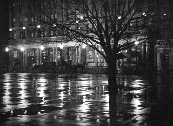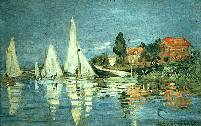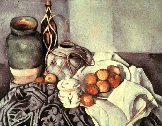

The history of art and design does not occur in a vacuum. Artists and designers are only responding to the events of their time. These are some of the issues that motivated changes in subject matter since the mid-19th century:
The social and political environment changed drastically during this period. Society moved from the ancient traditional rule of religiously sanctioned autocracies into an era of secular democracies and dictatorships. The industrial revolution also contributed to the restructuring of society. Technology, colonialism, and social change brought about contacts between peoples previously separated by distance, language, and social status. The result has been more than a century of turbulence, social struggle, and warfare, all of which can be seen in the arts of the times.
 Since the 1840s photography has offered a mechanical means of faithfully recording
visual data that surpassed the ability of the painter. The earliest commercially
successful form of photography was the daguerrotype (click on Gallery on the left).
Since photography could record visual data so perfectly, the artist was left to
wonder what he could do that the camera could not. This led to many experiments
in style, technique, and interpretation. For other examples of early photography,
try this link to Edweard Muybridge,
an early practitioner of stop-action photography; or this collection
of early photographs.
Since the 1840s photography has offered a mechanical means of faithfully recording
visual data that surpassed the ability of the painter. The earliest commercially
successful form of photography was the daguerrotype (click on Gallery on the left).
Since photography could record visual data so perfectly, the artist was left to
wonder what he could do that the camera could not. This led to many experiments
in style, technique, and interpretation. For other examples of early photography,
try this link to Edweard Muybridge,
an early practitioner of stop-action photography; or this collection
of early photographs.
 The creation of photographic images has also evolved into an art form in its
own right. Early practitioners such as
Matthew Brady ,
Alfred Stieglitz and others
brought the possibilities of the camera well beyond that of a mechanical device
for copying visual "facts." There has been an ongoing dialogue between the painter
and the photographer, as each has learned from the vision of the other.
The creation of photographic images has also evolved into an art form in its
own right. Early practitioners such as
Matthew Brady ,
Alfred Stieglitz and others
brought the possibilities of the camera well beyond that of a mechanical device
for copying visual "facts." There has been an ongoing dialogue between the painter
and the photographer, as each has learned from the vision of the other.
The existence of photographic images inspired artists to look for other subject
matter. Artists began to concern themselves with issues such as the effects of
light, the relationships of color, and the fundamental character of form and
mass. Comparisons of photographs with paintings by such artists as
Monet and
Cezanne show that the artist was selecting, simplifying, flattening,
intensifying, even abstracting the view which is before his eyes.


 |